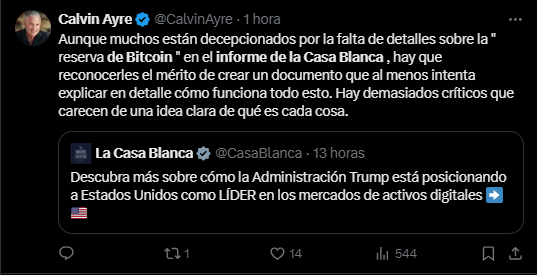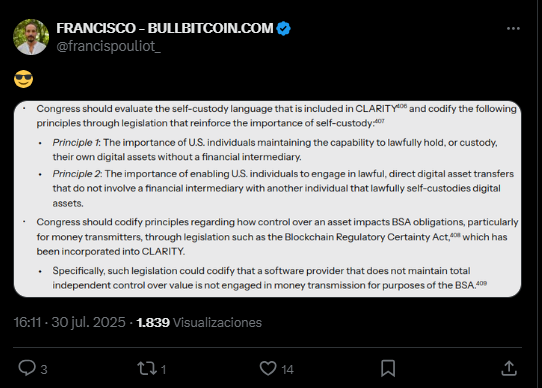The White House published an unprecedented report entitled “Strengthen American leadership in Digital Financial Technology,” showing, once again, that the United States seeks to regulate the digital asset industry and add bitcoin (BTC) to its strategic reserves, along with gold and currencies.
The document of more than 100 pages, prepared in compliance with an executive order of President Trump, proposes the creation of a “Bitcoin strategic reserve” and a “reserve of digital assets of the United States.” The plan, according to the document, would be implemented without new taxes, which has unleashed a wave of speculation about the possibility that the US government revalue or sells part of its vast gold reserves to acquire BTC.
But beyond the explosive holder, The report renews a complete paradigm shift in the position that the United States used to have to Bitcoin and other digital assets. It is a comprehensive plan to cement the leadership of the country in the new digital economy, recommending legislative measures to deregulate, innovate and protect, as Cryptonotics reported.
After the publication of the report, the Bitcoin community unleashed an intense debate that combines euphoria, skepticism and a detailed analysis. This shows that the content of the report did not meet everyone’s expectations.
The most optimistic faction sees the report as a historical validation. Users like Castom They summed up their vision in X (formerly Twitter): «White House update on cryptocurrencies! […] Uu. Drives leadership … exciting times are coming!
Its analysis highlights several key points that include the report such as the new laws for decentralized finances (DEFI) and Stablecoins, the CFTC supervising the markets and, crucially, the prohibition of the digital currencies of Central Banks (CBDC) that the Government ensures is to protect privacy.
This feeling is shared by Major Max Bitcoinwho Celebrate the green light at the stablecoins and the possible access of banks to offer services with bitcoin and cryptocurrencies. His comment goes one step further: «Liquidate Fort Knox’s gold reserves, buy Bitcoin at full machine for the Bitcoin strategic reserve. There they have their neutral budgetary regulations. You are welcome”.


This optimism has found a powerful ally in the Capitol. Senator Cynthia Lummis, one of the most influential pro -bit voices in American politics, who soon did praise the reportdescribing it as “an important step forward for the leadership of the United States in financial innovation.”
For Lummis, the proposals of the report are an echo of the policies that it has promoted for yearsfrom flexible regulatory frameworks (“Fintech Sandbox”) to fiscal reforms for miners and stakers. His support is total: “This year is the year of digital assets,” he said.
Also developers and technologists see something deeper. Sreeram Kannanfounder of Eigenlayer, a re-staking platform of Ethereum, expressed his surprise and enthusiasm for the change in government tone: “After really hard years from the regulatory point of view, I did not expect to see this great change in the attitude of the government.”
For him, the most exciting thing is to see that avant -garde technical concepts such as “Subtaking” and “data availability” are mentioned in a White House report. It is a recognition of the basic work that is being done in the industry, validating innovation far beyond financial speculation.
Where is the bitcoin that everyone expected?
However, not everyone manifests optimistic, because a part of the community indicates that the promises of the report are ambiguous or that, directly, they do not say what they expected.
The user Ai · Socatis Cool expectations with a more sober analysis: « – No Bitcoin reserve plan is mentioned – there is greater approach to risk regulation and mitigation. Digital assets are now framed as part of the US economic strategy. A step forward in politics, but no BTC in the balance (still).
For skeptics, The report represents an advance in regulatory policybut the proposal of a strategic BTC reserve is more an inference than a specific and detailed plan. This is because, since April, the community awaits with expectation that the government reveals how many bitcoins it really possesses and its strategies to accumulate.


Therefore, criticism revolves around the lack of transparency by the government. Joey Football summarize it strongly: «They only had to tell everyone how much Bitcoin has the US government, and everyone would be happy. However, they couldn’t even do that.
In short, the White House report is, without a doubt, a historical document. While the community is divided over the real scope of the proposal of a Bitcoin reserve, the consensus is clear at one point: the era of regulatory hostility seems to have ended.
The euphoria of some, the skepticism of others and the validation felt by the builders paint the portrait of a community that now looks towards Washington without fear and with a mixture of hope and demand. The White House document sets the words already mentioned above, but now what the Bitcoin community expects is that they become facts.


